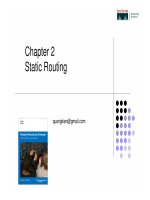Routing Protocols and Concepts: Chapter 11 ppt
Bạn đang xem bản rút gọn của tài liệu. Xem và tải ngay bản đầy đủ của tài liệu tại đây (1.22 MB, 111 trang )
Chapter 11
OSPF
2
For further information
This presentation is an
overview of what is
covered in the
curriculum/book.
For further explanation
and details, please read
the chapter/curriculum.
Book:
Routing Protocols
and Concepts
By Rick Graziani and
Allan Johnson
ISBN: 1-58713-206-0
ISBN-13: 978-58713-
206-3
3
Topics
Introduction to OSPF
Background of OSPF
OSPF Message
Encapsulation
OSPF Packet Types
Hello Protocol
OSPF LSUs
OSPF Algorithm
Administrative Distance
Authentication
Basic OSPF Configuration
Lab Topology
The router ospf command
The network command
OSPF Router ID
Verifying OSPF
Examining the Routing
Table
The OSPF Metric
OSPF Metric
Modifying the Cost of the
Link
OSPF and Multiaccess
Networks
Challenges in Multiaccess
Networks
DR/BDR Election Process
OSPF Interface Priority
More OSPF Configuration
Redistributing an OSPF
Default Route
Fine-tuning OSPF
Introduction to OSPF
Background of OSPF
OSPF Message Encapsulation
OSPF Packet Types
Hello Protocol
OSPF LSUs
OSPF Algorithm
Administrative Distance
Authentication
5
Introduction to OSPF
OSPF is:
Classless
Link-state routing protocol
Uses the concept of areas for scalability
RFC 2328 defines the OSPF metric as an arbitrary value called cost.
Cisco IOS software uses bandwidth to calculate the OSPF cost metric.
6
Background of OSPF
1987 - Initial development by IETF OSPF Working Group.
1989 - OSPFv1 was published in RFC 1131.
1991 - OSPFv2 was introduced in RFC 1247 by John Moy.
ISO was working IS-IS
IETF chose OSPF as its recommended IGP (interior gateway
protocol).
In 1998 - OSPFv2 specification was updated in RFC 2328 and is the
current RFC for OSPF.
7
OSPF Message
Encapsulation
This data field can include one of five OSPF packet types.
In the IP packet header:
Protocol field is set to 89 (OSPF)
Destination address is typically set to one of two multicast addresses:
224.0.0.5
224.0.0.6
If the OSPF packet is encapsulated in an Ethernet frame, the destination
MAC address is also a multicast address:
01-00-5E-00-00-05
01-00-5E-00-00-06
8
OSPF Packet
Types
Five types of OSPF LSPs (link-state packets).
Hello: Used to establish and maintain adjacency.
DBD (Database Description): Abbreviated list of the sending router’s link-
state database.
LSR (Link-State Request) : Used by routers to request more information
about any entry in the DBD.
LSU: (Link-State Update): Link-state information.
LSAck (LSA Acknowledgment): Router sends a link-state (LSAck) to
confirm receipt of the LSU.
Figure includes
CCNP information
9
Hello
Protocol
Discover neighbors (OSPF neighbors)
Establish adjacencies
Advertise parameters on which two routers must agree to become
neighbors
Hello Interval, Dead Interval, Network Type
Elect the Designated Router and Backup Designated Router on
multiaccess networks such as Ethernet and Frame Relay
Hello packets :
More in later
10
Hello
Protocol
Type: OSPF packet type: Hello (Type 1), DBD (Type 2), LS Request (Type
3), LS Update (Type 4), LS ACK (Type 5)
Router ID: ID of the originating router
Area ID: Area from which the packet originated
Network Mask: Subnet mask associated with the sending interface
Hello Interval: Number of seconds between the sending router’s Hellos
Router Priority: Used in DR/BDR election (discussed later)
Designated Router (DR): Router ID of the DR, if any
Backup Designated Router (BDR): Router ID of the BDR, if any
List of Neighbors: Lists the OSPF Router ID of the neighboring router(s)
These will be discussed
throughout this chapter.
11
Before an OSPF router can flood its link states, must discover neighbors.
Includes the OSPF Router ID (later)
Receipt confirms there is another OSPF router on this link.
Adjacency is now established.
Routers are not considered fully adjacent, at this point each router is aware of
the other OSPF router on the link.
Neighbor
Establishment
Note: Full adjacency
happens after both
routers have exchanged
any necessary LSUs
and have identical link-
state databases.
(CCNP)
More later
12
Before two routers can form an OSPF neighbor adjacency, they must agree
on three values:
Hello interval
Dead interval
Network type
Both the interfaces must be part of the same network, including having the
same subnet mask.
OSPF Hello and
Dead Intervals
More later
13
Hello Intervals
By default, OSPF Hello packets are sent:
10 seconds on multiaccess and point-to-point segments
30 seconds on nonbroadcast multiaccess (NBMA) segments (Frame
Relay, X.25, ATM).
In most cases, OSPF Hello packets are sent as multicast to an address
reserved for ALLSPFRouters at 224.0.0.5.
14
Dead Intervals
Dead interval - Period, expressed in seconds, that the router will wait to
receive a Hello packet before declaring the neighbor “down.”
Cisco uses a default of four times the Hello interval.
40 seconds - Multiaccess and point-to-point segments.
120 seconds - NBMA networks.
Dead interval expires
OSPF removes that neighbor from its link-state database.
Floods the link-state information about the “down” neighbor out all
OSPF-enabled interfaces.
Network types are discussed later in the chapter.
15
Electing a DR
and BDR
Election of Designated Router (DR) and Backup Designated Router
(BDR).
Used to reduce the amount of OSPF traffic on multiaccess networks
DR is responsible for updating all other OSPF routers.
BDR is the backup if the current DR fails.
R1, R2, and R3 are connected through point-to-point links.
No DR/BDR election occurs.
Much more later
More later
16
OSPF
LSUs
Link-State Updates (LSU) are the packets used for OSPF routing
updates.
Can contain 11 different types of LSAs (Link-State
Advertisements) (CCNP)
At times, these terms are used interchangeably.
17
OSPF Algorithm
Each OSPF router maintains a link-state database containing the
LSAs received from all other routers.
When a router has received all the LSAs and built its local link-state
database, OSPF uses Dijkstra’s shortest path first (SPF)
algorithm to create an SPF tree.
The SPF tree is then used to populate the IP routing table with the
best paths to each network.
18
Administrative Distance
Administrative distance (AD) is the
trustworthiness (or preference) of
the route source.
OSPF has a default AD of 110.
19
Authentication
OSPF can be configured for authentication.
This practice ensures that routers will only accept routing information from
other routers that have been configured with the same password or
authentication information.
Basic OSPF Configuration
Lab Topology
The router ospf command
The network command
OSPF Router ID
Verifying OSPF
Examining the Routing Table
21
Notice that the addressing scheme is discontiguous.
OSPF is a classless routing protocol.
There are three serial links of various bandwidths and that each router
has multiple paths to each remote network.
Topology
22
R1’s configuration
hostname R1
!
interface FastEthernet0/0
description R1 LAN
ip address 172.16.1.17 255.255.255.240
!
interface Serial0/0/0
description Link to R2
ip address 192.168.10.1 255.255.255.252
clock rate 64000
!
interface Serial0/0/1
description Link to R3
ip address 192.168.10.5 255.255.255.252
The current configurations do not include the interface bandwidth
command.
This means that the bandwidth value on the serial interfaces is set to the
default value of 1544 Kbps.
23
R2’s configuration
hostname R2
!
interface FastEthernet0/0
description R2 LAN
ip address 10.10.10.1 255.255.255.0
!
interface Serial0/0/0
description Link to R1
ip address 192.168.10.2 255.255.255.252
!
interface Serial0/0/1
description Link to R3
ip address 192.168.10.9 255.255.255.252
clock rate 64000
24
R3’s configuration
hostname R3
!
interface FastEthernet0/0
description R3 LAN
ip address 172.16.1.33 255.255.255.248
!
interface Serial0/0/0
description Link to R1
ip address 192.168.10.6 255.255.255.252
clockrate 64000
!
interface Serial0/0/1
description Link to R2
ip address 192.168.10.10 255.255.255.252
25
The router ospf Command
The process-id
Between 1 and 65,535
Chosen by the network administrator.
Locally significant:
Does not have to match other OSPF routers.
This differs from EIGRP.
We are using the same process ID simply for consistency.
R1(config)# router ospf 1
R1(config-router)#









